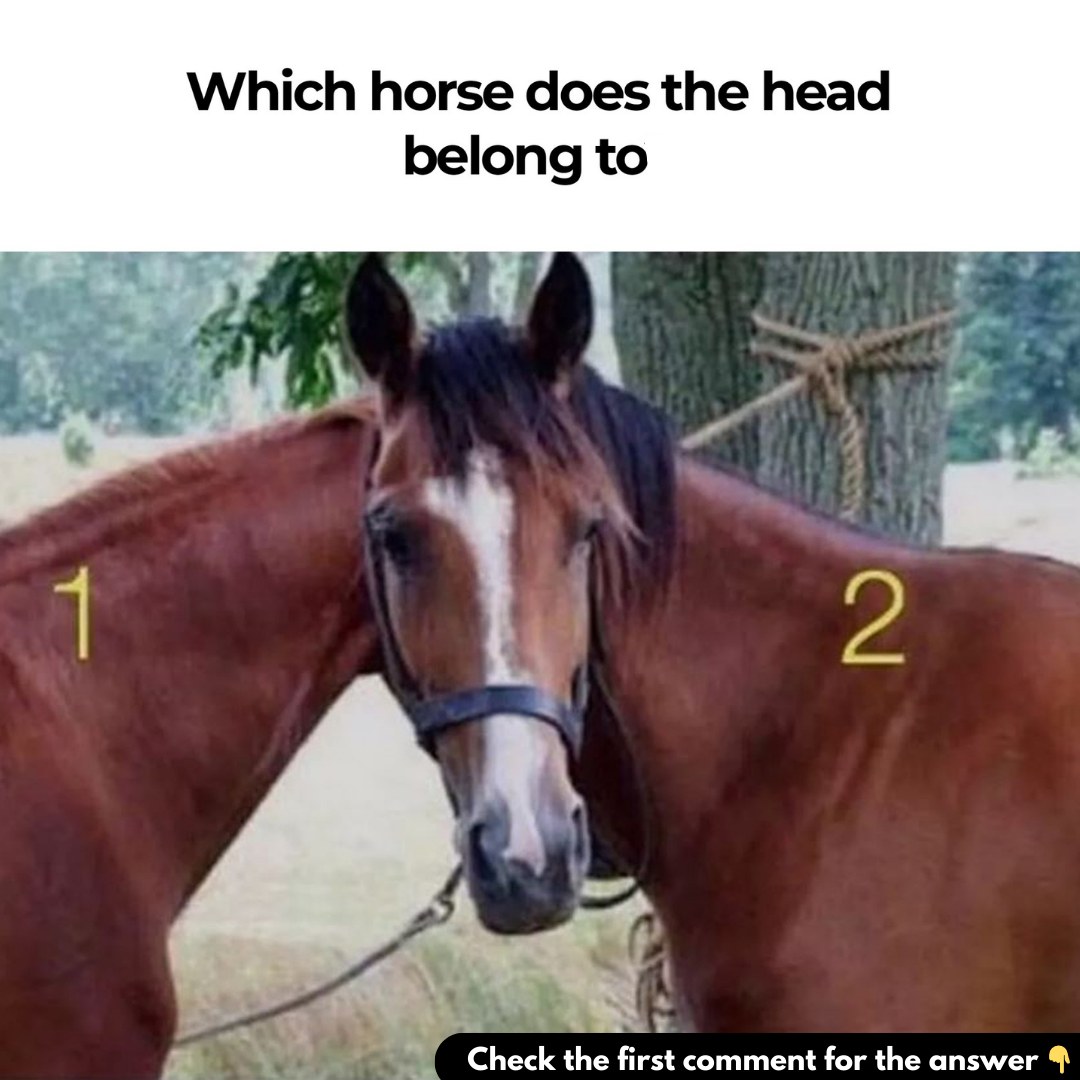Are you ready to put your observation skills to the test with an optical illusion that has baffled thousands? This viral brain teaser features two horses, and the challenge seems deceptively simple: Can you figure out which horse is standing in front? At first glance, the answer might seem obvious, but as you study the image more closely, you’ll realize there’s more to this puzzle than meets the eye. Let’s break it down and uncover the mystery hidden within this visual enigma.

The Timeless Appeal of Optical Illusions
For centuries, optical illusions have captivated our minds, challenging the way we perceive reality. These visual tricks exploit the brain’s reliance on patterns, assumptions, and visual cues, often leading to surprising results. This particular puzzle with two horses is a masterclass in perception—forcing us to slow down, observe carefully, and question what we think we see. But what makes optical illusions so universally fascinating? They aren’t just entertaining; they stimulate curiosity, sharpen focus, and remind us that our eyes and brains don’t always agree on what’s real.
Why This Puzzle Is So Challenging
Before we reveal the answer, let’s explore the common mistakes people make when trying to solve this illusion. These errors shed light on just how clever and deceptive visual puzzles can be:
-
- First Impressions Are Deceiving
At first glance, many people instinctively assume that the horse with the most prominent head is in the foreground. However, relying on this quick assessment often leads to the wrong conclusion. - Missing Subtle Details
Details such as the flow of the mane, the positioning of the reins, and the alignment of the neck are critical clues. Yet, many overlook these finer points, focusing only on the most obvious features.
- First Impressions Are Deceiving
- The Illusion of Symmetry
Our brains love patterns and symmetry. In this puzzle, symmetry creates an illusion that misleads observers into thinking the horses’ positions are different from reality. - Overthinking the Clues
Sometimes, people get so caught up in analyzing tiny details that they miss the broader picture. Overthinking can make a relatively simple puzzle seem far more complicated than it actually is.
Step-by-Step Guide to Solving the Illusion
To uncover which horse is standing in front, let’s carefully break down the image using a methodical approach:
Step 1: Take in the Whole Picture
Start by observing the image as a whole. Don’t let the horse heads dominate your focus. Instead, pay attention to how the horses’ necks, bodies, and features overlap.
Step 2: Follow the Mane
The mane is a critical clue in this illusion. Look at how the mane flows and connects with each horse’s body. In this puzzle, the mane flows naturally into the second horse’s body, which gives away its position in the foreground.
Step 3: Study the Reins
The reins are another important detail. Trace them from the horse’s head to where they connect with the body. In this image, the reins align more naturally with the second horse, further reinforcing its placement in the foreground.
Step 4: Observe the Neck Alignment
The muscles in a horse’s neck offer clues about its posture. The horse in the foreground will typically have a more contracted, upright neck. In contrast, the horse further back will appear more relaxed. In this case, the second horse’s neck is more rigid, indicating its closer position.
Step 5: Spot the Hidden Clue
If you look closely, you might even notice a hint of the first horse’s face peeking from behind the second horse’s neck. This final clue confirms that the second horse is indeed the one in the foreground.
The Final Answer: The Second Horse Is in Front
After carefully analyzing the image and following the steps above, it becomes clear that the second horse is standing in front. Its mane, reins, and neck alignment all point to this conclusion. While the puzzle initially seems straightforward, it’s the subtle clues that ultimately reveal the truth.
Why Are Optical Illusions So Good for Your Brain?
Beyond their entertainment value, optical illusions like this one offer several cognitive benefits:
- Sharper Observation Skills:
These puzzles force us to pay attention to details we’d usually overlook, training our brains to be more alert and perceptive. - Improved Problem-Solving Abilities:
Optical illusions teach us to approach problems from different angles and challenge assumptions, which is a valuable life skill. - Enhanced Patience and Focus:
Solving puzzles like this one requires patience and mental clarity. It’s easy to get frustrated, but persistence pays off. - Stimulated Creativity:
Thinking outside the box is essential for solving illusions. This creative approach to problem-solving carries over into other areas of life as well.
Did You Get It Right?
So, were you able to spot which horse was standing in front without peeking at the answer? Whether you nailed it on your first try or had to revisit the image a few times, this optical illusion serves as a perfect reminder of how our minds process visual information—and how easily they can be fooled.
Share this puzzle with friends and family and see if they can crack it. You might be surprised at how differently people approach the same image!
A Fun Reminder About Perception
This brain teaser isn’t just about identifying which horse is in front; it’s a testament to how our eyes and brains can sometimes mislead us. What seems obvious at first can become far more complex when analyzed closely. But therein lies the beauty of optical illusions—they remind us to slow down, pay attention, and question our assumptions.
So, the next time you encounter an optical illusion, take your time, follow the clues, and enjoy the mental workout. Not only will you sharpen your observation skills, but you’ll also experience the satisfaction of solving a puzzle that has stumped countless others.
In the end, puzzles like this aren’t just fun—they’re brain-boosting exercises wrapped in mystery. So keep your eyes sharp, your mind curious, and your patience steady. Happy puzzling!





